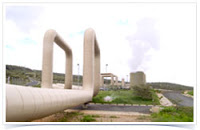 |
| A Geothermal Plant |
Currently, hydro is the leading source generating a 766.88MW which forms 65 per cent of the KenGen’s installed capacity. KenGen is the power generating utility. Kenya
However, the power generating company has firmly shifted its guns and is now targeting renewable sources of energy. It is now focused on developing geothermal and wind power as alternatives sources.
 |
| A wind Power |
In its current development programme which ends in 2016, the company will increase its power generating capacity by an additional 1832 MW by 2016. Of these, Hydro will generate an additional only 53MW while wind power will generate an additional 56.8 MW, geothermal will generate an additional 732MW over the same period. Coal will produce some 600MW while an LNG project to produce 300MW is being studied. Also being studied is another wind farm based in Marsabit County in Northern Kenya that potentially can generate 150MW.
In short, by 2016 Kengen’s 3000MW generating capacity will be dominated by geothermal at 882MW; Hydro at 820 MW; coal 600MW; wind 62 MW. If the Lake Turkana wind farm is added to the grid, Kenya
Geothermal energy is the natural heat stored within the earth’s crust. The energy is manifested on the earth’s surface in the form of fumaroles, hot springs
Olkaria II Power Station, Africa ’s largest Geothermal Power Station to date was built in the year 2000 and generates 70MW. It is the second geothermal plant owned and operated by KenGen. The second phase of Olkaria II was commissioned in 2010 injecting an extra 35 MW of power making a total of 150MW of power generated by geothermal means.
Hydro, is becoming an insignificant source because the rivers are not expanding. In fact, the source is unreliable as it relies heavily on rain-fed water to fill the dams. During drought, the water levels shrink forcing the country to revert to expensive thermal power. Such limitations would become a stumbling bloc to economic progress.
So in came geothermal power to the rescue. Although this quantity of geothermal power generated so far makes Kenya the leader in Africa Kenya
Going by the current KenGen’s development plan for the next four years, the goal is achievable. Of the six plants currently under construction, two generating 280MW will be commissioned in 2013, one, eburru, generating 2.5 Mw was commissioned last year and the other three, generating 452.5MW will be commissioned in 2016.
Sources indicate that constructing a 280 MW unit costs US$ 1billion (Kshs 84 billion). To develop 5000 MW will require 18 units which means that KenGen will need quite a neat pile of cash to construction the 18 units. However, with the rapid growth of the Kenyan economy, especially with the growth of Greenfield
On wind farms KenGen has apparently borrowed a leaf from it competitor in this respect, the Lake Turkana Wind Power project which hope to generate 300MW into the national grid starting next year. Already KenGen has a wind farm in Ngong near Nairobi
In addition, the firm expects to commission another 50MW wind farm in Isiolo to support the growth of the resort city in that town. Further North, KenGen is carrying feasibility studies for a further 150MW wind generated power in Marsabit County
Kenya Electricity Generating Company Limited, KenGen, is the leading electric power generation company in Kenya
Readers of this page also visited http://eaerb.blogspot.com/
Readers of this page also visited http://eaerb.blogspot.com/
